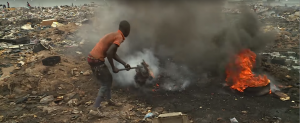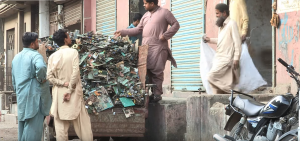Bill Rathje’s research of the American landfill painted a dark tale of the direction of our consumerist society. The immense waste of resources and lack of accountability will, according to Rathje, eventually lead to a culture collapse. Looking into today, we face more challenges despite the enormous technological progress we’ve enjoyed. Rather than improve our situation and more effectively use our resources, we face new issues in the form of electronic waste, the discard of electrical and electronic devices.
Today, much of the world’s e-waste originates from developed nations in the Western World such as the United States and Europe. The United Nations estimates that over 50 million tons of e-waste are discarded each year. And as our world’s reliance on technology grows and our current products updated, this number is sure to increase.
It is estimated that 75% of all e-waste is exported to developing countries around the world such as Ghana and Pakistan. The recycling of e-waste is often too costly in developed countries, making dumping a more economical option. Additionally, exporting out e-waste likely prevents the environmental and health dangers of recycling.
In cities where e-waste is dumped, such as Agbogbloshie, Ghana, and Karachi, Pakistan, the local communities have repurposed the e-waste into an economy based on the recycling and reuse of the dumped appliances. They are either repaired in order to be resold, or more likely, disassembled to recover raw materials such as copper, silver, gold, and steel.

Figure 1. A worker burns away wiring insulation in order to extract the copper in Agbobloshie, Ghana.
The dumping of e-waste presents enormous health and environmental concerns to the local community. In the case of Agbogbloshie and Karachi, people are continually affected by the toxins and chemicals released by the burning of e-waste. Workers, especially, are affected by the toxic chemicals as they extract the raw materials from the e-waste. Almost everyone becomes at risk from exposure to lead, cadmium, and other disruptive chemicals.
Studying communities such as Agbogbloshie and Karachi reveals the patterns that affect e-waste dumpsites around the world. For example, even in such an environment such as Agbogbloshie and Karachi, there remains a stark divide between those who utilize the e-waste. ‘Resellers’, often able to receive old or unused electronics, are able to make profits of thousands of Euros a month. Meanwhile, the majority of e-waste workers rely on a subsistence scavenging for grams of materials at a time. Also, the exploitation of developing countries as dumping grounds hark back to previous colonial exploitation of natural resources. And finally, it is the poor that are the most affected by the dumping of e-waste.
In summation, the dump of e-waste in developing countries does not represent an adequate solution as our world becomes both more technologically advanced and consumerist. The dumping of e-waste reflects just a transference of the root problem to other groups and cultures. All in all, e-waste represents the denial and postponement of developed nations actively addressing the growing environmental and health dangers of our trash.
Works Cited:
Blau, John
2006 UN summit on e-waste. CIO UK. CIO UK, 28 November 2006.
<https://www.cio.co.uk/it-leadership/un-summit-on-e-waste-316/>.
Accessed September 16, 2018.
Kuper, Jo
2008 Poisoning the poor: Electronic waste in Ghana. Greenpeace. Greenpeace, August 2008.<https://www.greenpeace.org/denmark/Global/denmark/p2/other/report/2008/poisoning-the-poor-electroni.pdf>. Accessed September 16, 2018.
2016 ToxiCity: life at Agbobloshie, the world’s largest e-waste dump in Ghana. YouTube. Youtube, 01 June 2016. <https://www.youtube.com/watchv=mleQVO1Vd1I&t=1226s>.
accessed September 16, 2018.
2016 The Toxic E-Waste Trade Killing Pakistan’s Poorest. YouTube. YouTube, 11 July 2016. <https://www.youtube.com/watch?v=axYKPbr9_MA>. accessed September 16, 2018.


I love how you connected archaeology to a real life social issue that is plaguing the world today–what do we do with our e-waste? It is a real problem and is rooted in environmental racism. I wanted to know if you could speak to possible solutions or community efforts to help the problem? A lot of archaeology of today is rooted in communities and working on archaeological problems that directly effect a community; they do things like work with Indigenous groups in the United States to try and provide significant ‘Western’ proofs for the Federal government to get land and tribal recognition. These approaches are sometimes rooted in what is labeled Indigenous archaeology. How do you think an approach like this could help these communities where developed countries are dumping and ruining these communities? What will happen to these workers who found a new industry within their precarious lives? Do they go back to being poor again?